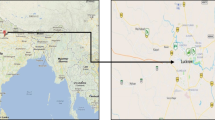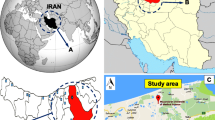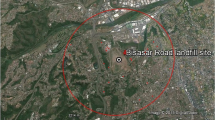Abstract
Hospitals are microenvironments containing populations with potentially enhanced sensitivity to air pollution. The objectives of this study were to characterize the concentration of indoor and outdoor size-fractionated particulate matter (PM) at two urban hospital sites in Kashan, Iran, and to evaluate the relationship between indoor and outdoor PM levels. PM1.0, PM2.5, and PM10 concentrations were measured over a 3-month period outside each hospital with parallel sampling at four indoor locations in patient wards. The results indicated that mean indoor concentrations at the sampling sites (PM1.0 = 17.8 μg/m3, PM2.5 = 45.5 μg/m3, and PM10 = 162.7 μg/m3) were found to be lower than outdoors levels (PM1.0 = 20.6 μg/m3, PM2.5 = 62.1 μg/m3, and PM10 = 300.6 μg/m3). Outdoor and indoor PM mass concentrations were associated with PM1.0, PM2.5, and PM10.0. Ambient wind speed also influenced the indoor/outdoor relationship for PM1.0 and PM2.5 but not for PM10. The average I/O ratios for PM2.5 in the intensive care unit (ICU) and children’s ward at Shahid Beheshti Hospital were close to or above 1.00. Indoor PM1.0 and PM2.5 concentrations were found to be positively associated with outdoor PM1.0 and PM2.5 concentrations, but no relationship was observed with PM10. The present findings may inform policymakers in implementing evidence-based efforts for the aim of improving the indoor air quality in closed and confined spaces.



Similar content being viewed by others
References
Campbell H (1997) Indoor air pollution and acute lower respiratory infections in young Gambian children. Health Bull 55:20
Chamseddine A, El-Fadel M (2015) Exposure to air pollutants in hospitals: indoor–outdoor correlations. WIT Trans Built Env 168:707–716
Chen C, Zhao B (2011) Review of relationship between indoor and outdoor particles: I/O ratio, infiltration factor and penetration factor. Atmos Environ 45:275–288
Dehghani M, Kamali Y, Shamsedini N, Ghanbarian M (2015) A study of the relationship between indoor/outdoor particle concentration in Dena hospital in Shiraz. J Health Res Community 1:49–55
Dehghani M, Saeedi AA, Zamanian Z (2012) A study of the relationship between indoor and outdoor particle concentrations in Hafez Hospital in Shiraz, Iran
Eames I, Tang J, Li Y, Wilson P (2009) Airborne transmission of disease in hospitals. J R Soc Interface 6:1–9
Esworthy R (2015) 2006 National Ambient Air Quality Standards (NAAQS) for fine particulate matter (PM2.5): designating nonattainment areas, congressional research service report, December 23, 2015, Fayetteville, USA
Ezzati M, Kammen DM (2001) Indoor air pollution from biomass combustion and acute respiratory infections in Kenya: an exposure-response study. Lancet 358:619–624
Ghozikali M, Borgini A, Tittarelli A, Amrane A, Mohammadyan M, Heibati B, Yetilmezsoy K (2016a) Quantification of health effects of exposure to air pollution (PM10) in Tabriz, Iran. Global NEST J 18:708–720
Ghozikali MG, Heibati B, Naddafi K, Kloog I, Conti GO, Polosa R, Ferrante M (2016b) Evaluation of chronic obstructive pulmonary disease (COPD) attributed to atmospheric O3, NO2, and SO2 using Air Q model (2011–2012 year). Environ Res 144:99–105
Gurley ES, Homaira N, Salje H, Ram PK, Haque R, Petri W, Bresee J, Moss WJ, Breysse P, Luby SP, Azziz-Baumgartner E (2013) Indoor exposure to particulate matter and the incidence of acute lower respiratory infections among children: a birth cohort study in urban Bangladesh. Indoor Air 23:379–386
Kermani M, Arfaeinia H, Nabizadeh R, Alimohammadi M, Aalamolhoda A (2015) Levels of PM2.5-associated heavy metals in the ambient air of Sina hospital district, Tehran, Iran. J Air Pollut Health 1:1–6
Klepeis NE, Nelson WC, Ott WR, Robinson JP, Tsang AM, Switzer P, Behar JV, Hern SC, Engelmann WH (2001) The National Human Activity Pattern Survey (NHAPS): a resource for assessing exposure to environmental pollutants. J Expo Sci Environ Epidemiol 11:231–252
Lomboy MFTC, Quirit LL, Molina VB, Dalmacion GV, Schwartz JD, Suh HH, Baja ES (2015) Characterization of particulate matter 2.5 in an urban tertiary care hospital in the Philippines. Build Environ 92:432–439
López-Villarrubia E, Iñiguez C, Costa O, Balleste F (2016) Acute effects of urban air pollution on respiratory emergency hospital admissions in the Canary Islands. Air Qual Atmos Health 9:713–722
Massey D, Masih J, Kulshrestha A, Habil M, Taneja A (2009) Indoor/outdoor relationship of fine particles less than 2.5 μm (PM2.5) in residential homes locations in central Indian region. Build Environ 44:2037–2045
Mohammadyan M, Alizadeh-Larimi A, Etemadinejad S, Latif MT, Heibati B, Yetilmezsoy K, Abdul-Wahab SA, Dadvand P (2017a) Particulate air pollution at schools: indoor-outdoor relationship and determinants of indoor concentrations. Aerosol Air Qual Res 17:857–864
Mohammadyan M, Ghoochani M, Kloog I, Abdul-Wahab SA, Yetilmezsoy K, Heibati B, Pollitt KJG (2017b) Assessment of indoor and outdoor particulate air pollution at an urban background site in Iran. Environ Monit Assess 189:235
Park M, Luo S, Kwon J, Stock TH, Delclos G, Kim H, Yun-Chul H (2013) Effects of air pollution on asthma hospitalization rates in different age groups in metropolitan cities of Korea. Air Qual Atmos Health 6:543–551
Pope R, Stanley KM, Domsky I, Yip F, Nohre L, Mirabelli MC (2017) The relationship of high PM2.5 days and subsequent asthma-related hospital encounters during the fireplace season in Phoenix, AZ, 2008–2012. Air Qual Atmos Health 10:161–169
Rezaei S, Naddafi K, Jabbari H, Yonesian M, Jamshidi A, Sadat A, Raygan Shirazinejad A (2013) Relationship between the particulate matter concentrations in the indoor and ambient air of the Tehran children hospital in 2007. Iran J Health Environ 6:103–112
Slezakova K, da Conceição Alvim-Ferraz M, do Carmo Pereira M (2012) Elemental characterization of indoor breathable particles at a Portuguese urban hospital. J Toxic Environ Health A 75:909–919
Smith KR, Samet JM, Romieu I, Bruce N (2000) Indoor air pollution in developing countries and acute lower respiratory infections in children. Thorax 55:518–532
Vu TV, Ondracek J, Zdímal V, Schwarz J, Delgado-Saborit JM, Harrison RM (2017) Physical properties and lung deposition of particles emitted from five major indoor sources. Air Qual Atmos Health 10:1–14
Wang F, Meng D, Li X, Tan J (2016) Indoor-outdoor relationships of PM2.5 in four residential dwellings in winter in the Yangtze River Delta, China. Environ Pollut 215:280–289
Wang X, Bi X, Sheng G, Fu J (2006) Hospital indoor PM10/PM2.5 and associated trace elements in Guangzhou, China. Sci Total Environ 366:124–135
World Health Organization (WHO) (2004) Health aspects of air pollution, results from the WHO project: systematic review of health aspects in Europe. WHO Press, Copenhagen
World Health Organization (WHO) (2006) Air quality guidelines: global update 2005, particulate matter, ozone, nitrogen dioxide and sulfur dioxide. WHO Regional Office for Europe, Copenhagen
World Health Organization (WHO) (2007) Health risks of heavy metals from long range trans-boundary air pollution. WHO Press, Copenhagen
World Health Organization (WHO) (2009) Global health risks: mortality and burden of disease attributable to selected major risks. WHO Press, Geneva
Yurtseven E, Erdogan MS, Ulus T, Alver Sahin U, Onat B, Erinoz E, Vehid S, Koksal S (2012) An assessment of indoor PM2.5 concentrations at a medical faculty in Istanbul, Turkey. Environ Prot Eng 38:115–127
Zereini F, Wiseman CL (2010) Urban airborne particulate matter: origin, chemistry, fate and health impacts. Springer, Berlin. https://doi.org/10.1007/978-3-642-12278-1
Zhao L, Chen C, Wang P, Chen Z, Cao S, Wang Q, Xie G, Wan Y, Wang Y, Lu B (2015) Influence of atmospheric fine particulate matter (PM2.5) pollution on indoor environment during winter in Beijing. Build Environ 87:283–291
Acknowledgements
The authors thank the manager and personnel of the Shahid Beheshti and Naghavi Hospitals for their kind cooperation.
Funding
This work was financially supported by Mazandaran University of Medical Sciences (Award Number: 93-7225).
Author information
Authors and Affiliations
Corresponding author
Ethics declarations
Conflict of interest
The authors declare that they have no conflict of interest.
Electronic supplementary material
ESM 1
(DOCX 141 kb)
Rights and permissions
About this article
Cite this article
Mohammadyan, M., Keyvani, S., Bahrami, A. et al. Assessment of indoor air pollution exposure in urban hospital microenvironments. Air Qual Atmos Health 12, 151–159 (2019). https://doi.org/10.1007/s11869-018-0637-6
Received:
Accepted:
Published:
Issue Date:
DOI: https://doi.org/10.1007/s11869-018-0637-6




